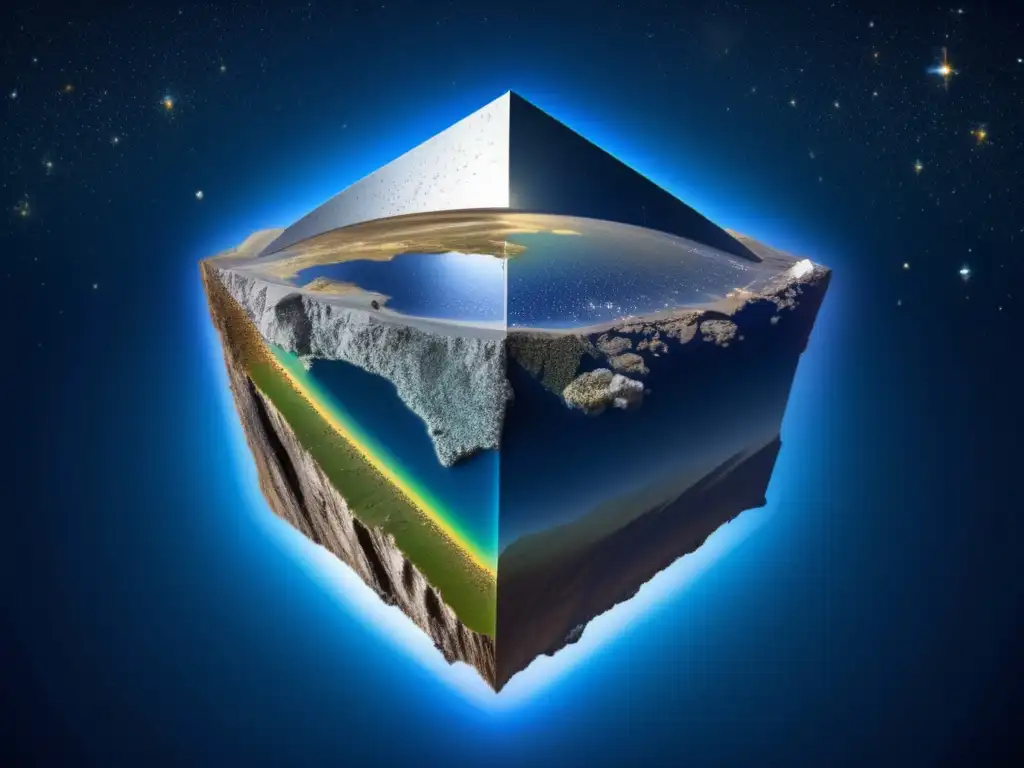The Iridium Layer: How Asteroids Left A Global Fingerprint

Introduction
Asteroids are space rocks that can travel at high speeds and collide with other celestial bodies, including Earth. The impact of asteroids can have devastating effects on our planet, including mass extinctions and geological changes. In studying the aftermath of asteroid impacts, scientists have discovered a unique marker left behind: the iridium layer.
The Formation of the Iridium Layer

What is Iridium?
Iridium is a rare metal that is found in the Earth's mantle and core. It is also present in asteroids, where it exists in concentrations that are hundreds of times greater than in the Earth's crust.
The Chicxulub Crater
The Chicxulub crater is an impact site located in the Yucatan Peninsula, Mexico, that was formed by a massive asteroid impact around 65 million years ago. This impact led to the extinction of the dinosaurs and marks the most recent mass extinction event on Earth. The impact released enormous amounts of energy, creating a fireball, shock waves, and causing massive wildfires. The impact also threw up rock and debris, some of which entered the atmosphere and then settled on the Earth's surface. One of the materials that were dispersed around the globe was the element iridium. When this material settled on the Earth, it created a layer that has been found in rocks all over the planet.
The Significance of the Iridium Layer
The discovery of the iridium layer was a significant breakthrough in the study of mass extinctions and the role of asteroids in shaping the planet's history. The presence of an element that is rare on Earth but abundant in asteroids led scientists to theorize that the asteroid impact was responsible for the extinction event and that the asteroid had originated from the asteroid belt between Mars and Jupiter.
The Importance of Studying the Iridium Layer

Understanding Mass Extinctions
Studying the iridium layer provides valuable insights into mass extinctions and their causes. By analyzing the distribution and composition of the iridium layer, scientists can explore the amount of material that was ejected during the impact and how far it traveled. This information can help us better understand the extent of the environmental changes that occurred following the impact, such as acid rain, global cooling, and the release of toxic gases.
Tracking Asteroid Impacts
The discovery of the iridium layer has also helped researchers track other asteroid impacts throughout history. By analyzing the layers in rocks, scientists can determine when an asteroid impact occurred and its magnitude. This information is useful for understanding the frequency and scale of asteroid impacts and for developing strategies to mitigate the potential effects of future impacts.
Exploring the Solar System
Studying the iridium layer and its origins also provides insight into the formation and composition of the solar system. It is believed that the iridium layer originated from a large asteroid that collided with Earth, providing a glimpse into the makeup of asteroids and their potential impact on the planets they encounter.
Frequently Asked Questions

-
What is the iridium layer?
The iridium layer is a layer of rock that contains high concentrations of the metal iridium, which is believed to have been deposited on the Earth's surface following the impact of an asteroid.
-
Why is the iridium layer significant?
The discovery of the iridium layer has helped scientists better understand mass extinctions and the role of asteroids in shaping the planet's history. It also provides insights into the formation and composition of the solar system.
-
How do scientists study the iridium layer?
Scientists study the iridium layer by analyzing rocks from different parts of the world and examining the layers within them. By analyzing the distribution and composition of the iridium layer, scientists can explore the extent of the environmental changes that occurred following the impact of an asteroid.
-
What other elements are associated with asteroid impacts?
Other elements that are associated with asteroid impacts include platinum, osmium, and nickel.
-
What can we learn from studying asteroid impacts?
Studying asteroid impacts can help us better understand the history of the planet and the solar system, track the frequency and scale of impacts, and develop strategies to mitigate their potential effects.
Conclusion
The discovery of the iridium layer has provided valuable insights into mass extinctions, asteroid impacts, and the formation and composition of the solar system. Studying the iridium layer and other markers left behind by asteroids can help us better understand the history of the planet and develop strategies to mitigate the potential effects of future impacts. As we continue to explore the universe and its many mysteries, the study of asteroids and their impact on our planet will undoubtedly remain a critical area of research.
Additional Resources

For more information on asteroid impacts and the study of asteroids, check out these resources:
- NASA Asteroid Redirect Mission
- Science Direct: Asteroid Impacts
- NASA Jet Propulsion Laboratory: Asteroid Watch
 Skyfall: The Cosmic Event That Ended The Dinosaur Era
Skyfall: The Cosmic Event That Ended The Dinosaur Era Asteroids And The Age Of Reptiles: A Terminal Connection
Asteroids And The Age Of Reptiles: A Terminal Connection The Asteroid That Shook The World: The End Of The Mesozoic Era
The Asteroid That Shook The World: The End Of The Mesozoic EraIf you want to discover more articles similar to The Iridium Layer: How Asteroids Left A Global Fingerprint, you can visit the Asteroids and Dinosaurs category.
Leave a Reply

Articulos relacionados: